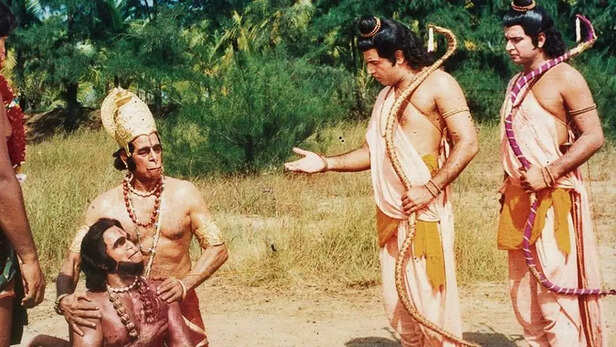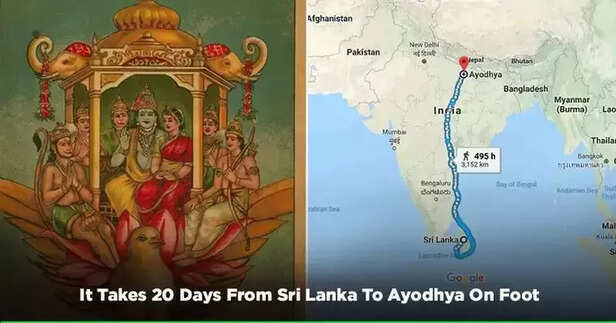Kishkindha’s Cave Paintings: Did Ram and Hanuman Really Walk These Lands?
Nidhi | Jan 30, 2025, 23:59 IST
( Image credit : Times Life Bureau, Timeslife )
In the heart of India’s ancient landscapes, Kishkindha stands as a revered site rich in mythological history, particularly associated with the Ramayana. The cave paintings discovered here have sparked a new debate—could these ancient artworks provide real evidence of Ram and Hanuman's existence? This article delves deep into the historical and spiritual significance of Kishkindha’s caves, exploring how the depictions of these divine figures might link the Ramayana to tangible proof. Join us on a journey through ancient art, myth, and archaeological discovery, as we unravel the mysteries hidden within Kishkindha’s sacred lands.
Imagine standing amidst the boulders of Hampi, where the winds hum ancient melodies and the rocks seem to hold secrets from an age long past. What if these very stones could speak? Would they tell us of Lord Rama’s footsteps on this sacred land? Of Hanuman’s boundless leaps across the sky?
Kishkindha—often identified with present-day Hampi—is not just a name in the Ramayana; it is a land of legends, a kingdom of vanaras, and a bridge between mythology and history. But is there real evidence to suggest that Ram and Hanuman once roamed here? Or is it just faith woven into the landscape?
Let’s embark on this mystical journey to uncover the truths hidden within Kishkindha’s caves, scriptures, and stones.

In the fourth book of the Ramayana, the Kishkindha Kanda, Valmiki paints a vivid picture of a land ruled by the vanaras—intelligent, powerful monkey-like beings. Here, Rama and Lakshmana arrived in search of Sita, only to meet Sugriva, the rightful king, who had been overthrown by his brother Vali.
 Among the rugged terrain of Hampi, ancient carvings whisper of times long gone.
Among the rugged terrain of Hampi, ancient carvings whisper of times long gone.
Scholars remain divided. Some argue that the carvings belong to later medieval periods and were inspired by the Ramayana rather than being actual remnants of its time.
The quest to prove the Ramayana as historical fact faces an eternal challenge—time has erased much of the physical traces.

So, while the soil may not yet yield a signboard reading “Rama Was Here,” the faith of millions still believes in the sacred footprints embedded in time.
For believers, the evidence is not in stone, but in spirit. The energy of Hampi is undeniable—whether you walk through the ruins at sunrise or witness the towering presence of Anjaneya Hill, there is an aura that makes one pause.
So, did Rama and Hanuman truly walk these lands? The answer lies in the eyes of the beholder.
And as the sun sets over the boulders of Hampi, casting long shadows that whisper ancient legends, one thing is certain—Kishkindha will forever be a land where faith walks hand in hand with history.
Kishkindha—often identified with present-day Hampi—is not just a name in the Ramayana; it is a land of legends, a kingdom of vanaras, and a bridge between mythology and history. But is there real evidence to suggest that Ram and Hanuman once roamed here? Or is it just faith woven into the landscape?
Let’s embark on this mystical journey to uncover the truths hidden within Kishkindha’s caves, scriptures, and stones.
Kishkindha: The Monkey Kingdom in the Ramayana

Ramayana
( Image credit : Times Life Bureau )
In the fourth book of the Ramayana, the Kishkindha Kanda, Valmiki paints a vivid picture of a land ruled by the vanaras—intelligent, powerful monkey-like beings. Here, Rama and Lakshmana arrived in search of Sita, only to meet Sugriva, the rightful king, who had been overthrown by his brother Vali.
- This land saw Rama forge an unbreakable bond with Hanuman.
- It was from here that Hanuman took his legendary leap to Lanka.
- The mighty Vanara army, led by Sugriva, pledged allegiance to Rama, setting the stage for the great war against Ravana.
Cave Paintings and Ancient Inscriptions: Etchings of the Past?

Hanuman
( Image credit : Times Life Bureau )
- Some inscriptions and sculptures depict scenes eerily similar to the Ramayana—Sugriva’s coronation, Vali’s battle, and Hanuman’s mighty leaps.
- The Vali-Sugriva Cave is said to be the very place where the brothers fought for the throne.
- Anjaneya Hill is believed to be the birthplace of Hanuman, where devotees still bow their heads in reverence.
Scholars remain divided. Some argue that the carvings belong to later medieval periods and were inspired by the Ramayana rather than being actual remnants of its time.
Archaeological Dilemmas: Myth vs. Material Evidence

Ramayana Proof
- Excavations in Kishkindha have not yet uncovered definitive artifacts that can be directly linked to Lord Rama or Hanuman.
- While many structures and caves match descriptions from the epic, archaeologists caution against jumping to conclusions.
- The absence of physical proof, however, does not diminish the deep cultural and spiritual belief surrounding these sites.
So, while the soil may not yet yield a signboard reading “Rama Was Here,” the faith of millions still believes in the sacred footprints embedded in time.
Faith Over Facts? The Spiritual Resonance of Kishkindha
- Pilgrims chant Rama’s name as they ascend Hanuman’s supposed birthplace.
- The Tungabhadra River flows like an eternal witness to the past, as described in Valmiki’s verses.
- Every temple and carving is more than just art—it is a portal into devotion, an echo of divine footsteps.
The Eternal Legacy of Kishkindha
- If you seek hard archaeological proof, the quest continues.
- If you seek spiritual connection, Kishkindha has already answered.
And as the sun sets over the boulders of Hampi, casting long shadows that whisper ancient legends, one thing is certain—Kishkindha will forever be a land where faith walks hand in hand with history.
